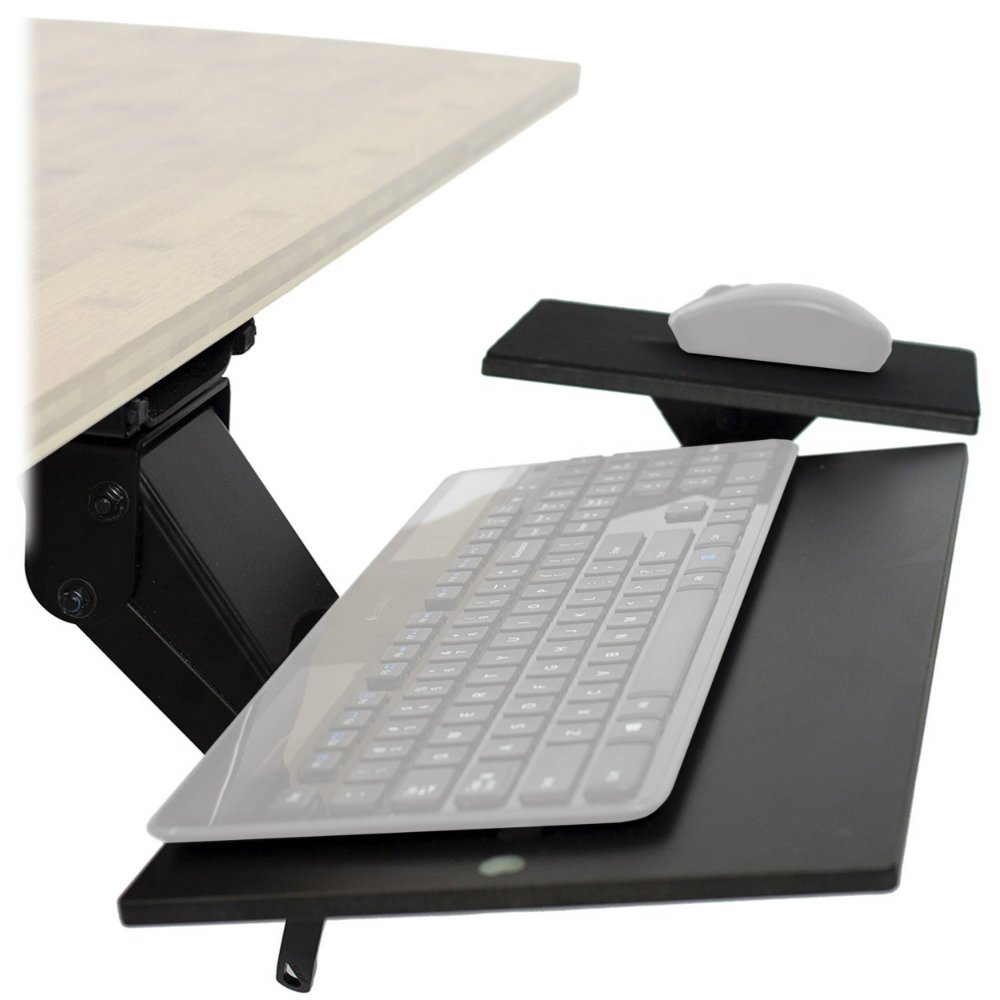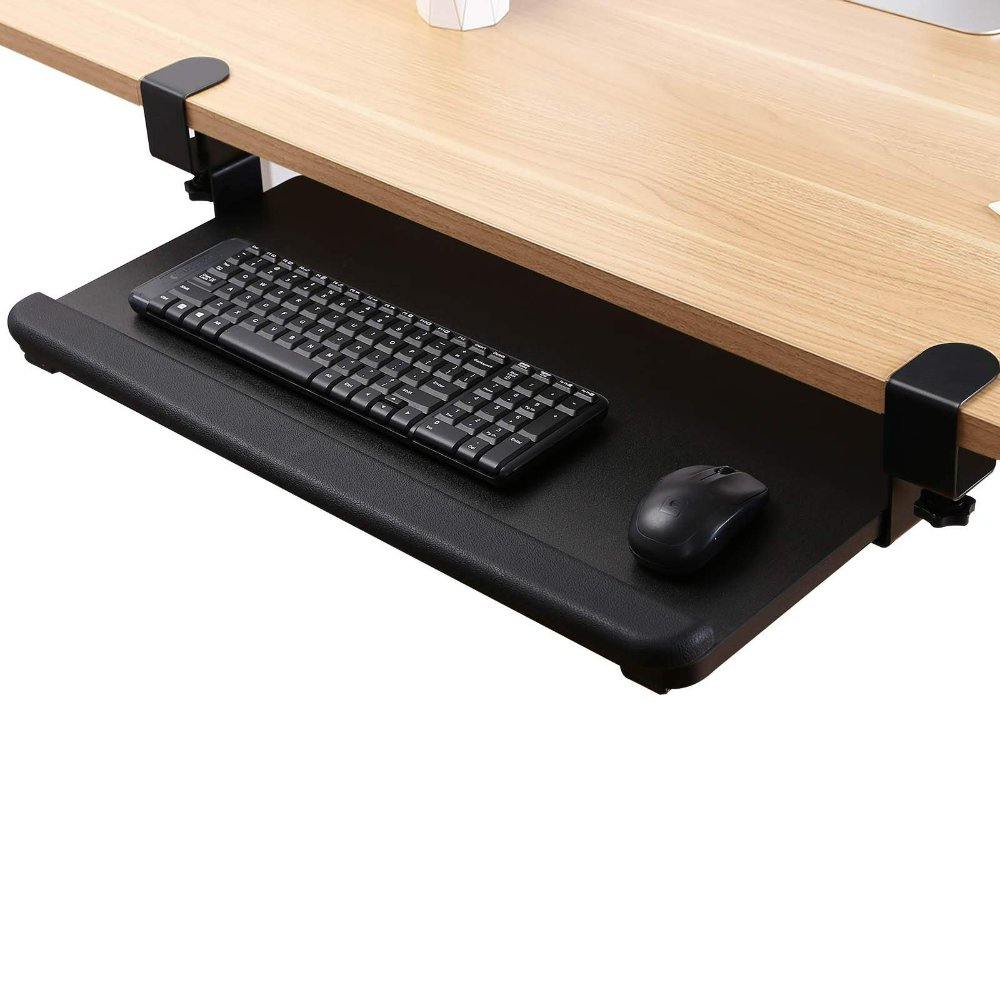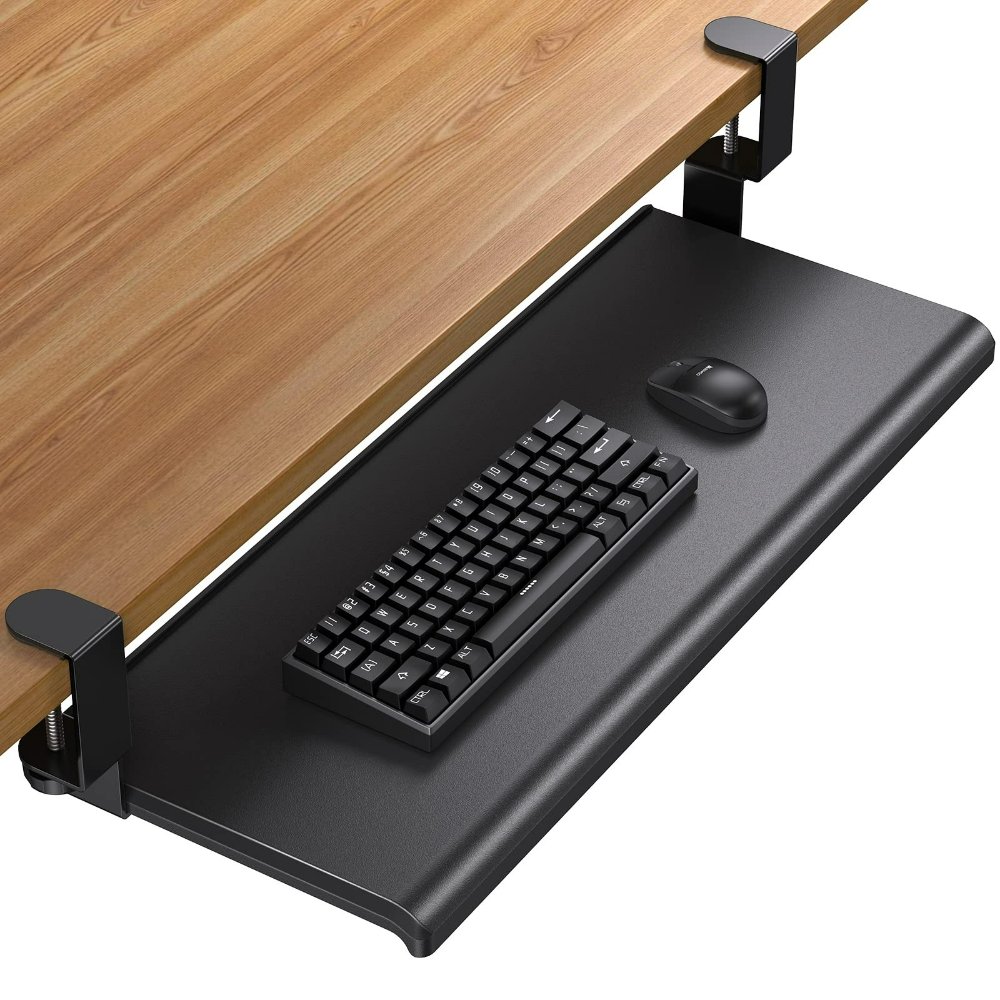What Is a Keyboard Tray?
A keyboard tray is a movable platform. It holds a keyboard and often a mouse. You can attach it under your desk. This lets you adjust its height and angle. That adjustment helps you type more comfortably. It slides in and out, too. This means you can tuck it away when not in use.
A good keyboard tray is sturdy and ergonomic. ‘Ergonomic’ here means it’s designed for comfort and efficiency. Many trays tilt, swivel, and slide. These features help you find a good position for your wrists and arms. Proper positioning can prevent strain. It can also reduce the risk of repetitive stress injuries.
People with limited desk space benefit from keyboard trays. When desk space matters, a tray optimizes your area. It gives more room for other tasks. It is great for multitaskers. Offices, home workstations, and gaming setups often use them. Teachers and students like them too. They are a smart choice for anyone who uses a computer often.

The Benefits of Using a Keyboard Tray
Using a keyboard tray offers several advantages. First, it improves posture. By adjusting the tray, you can keep your wrists straight and your arms at a comfortable angle. This leads to better overall posture at your desk. Better posture reduces the risk of musculoskeletal problems.
A keyboard tray also saves space. It frees up the top of your desk for other items. This is important in small work areas. By sliding under the desk when not in use, it maximizes your workspace. You can work on multiple projects without clutter.
Another benefit is the promotion of good health. A well-positioned keyboard tray helps prevent conditions like carpal tunnel syndrome. It allows you to type in a way that reduces strain on your wrists and arms. Over time, this can result in fewer health issues related to computer use.
Keyboard trays also improve typing speed and accuracy. With the keyboard at the right height and angle, you can type faster. You also make fewer mistakes. This boosts productivity. It’s helpful for those who spend a lot of time typing.
Finally, keyboard trays can enhance the aesthetics of your workspace. They come in various designs. Many trays blend well with modern office furniture. A sleek and tidy desk area can create a more enjoyable working environment.
In summary, a keyboard tray is not just an accessory. It is a beneficial tool for anyone who spends time at a computer. Whether you’re gaming, working, or studying, a tray can make a big difference.
Different Types of Keyboard Trays
When shopping for a keyboard tray, you’ll find several types to choose from. Knowing the differences helps you decide the best fit for your needs.
Adjustable Keyboard Trays
Adjustable trays let you change the height and tilt. They suit various user heights and preferences. Look for ones that are easy to adjust.
Under-Desk Keyboard Trays
These models attach beneath your desk. They slide out and in effortlessly. They’re great for saving space.
Corner Keyboard Trays
Corner trays are perfect for L-shaped desks. They maximize space in corner workstation setups.
Wall-Mounted Keyboard Trays
If you lack desk space, consider a wall-mounted tray. It attaches to the wall and can fold away when not in use.
Clamp-On Keyboard Trays
For easy installation, go for clamp-on trays. They attach to the desk edge without the need for tools.
Sit-Stand Keyboard Trays
These trays fit well with adjustable desks. They move up and down, so you can stand or sit. This type supports an active work style.
Each type of keyboard tray has unique features. Think about your desk layout and work habits. This will guide your choice. Remember, the right tray keeps you comfortable and productive.

How to Measure Your Workspace for a Keyboard Tray
Before buying a keyboard tray, measuring your workspace is crucial. Proper fit is key to comfort and convenience. Here’s how to do it:
- Measure Your Desk Area: Check the width and depth of your desk. Ensure there’s enough space to mount a tray. Write down these dimensions.
- Check Under-Desk Space: Look for obstructions underneath. Drawer units or crossbars may limit where a tray fits.
- Desk Thickness: Measure the edge thickness. This is important for clamp-on trays and helps with a secure fit.
- Sitting Height: Sit in your chair comfortably. Measure from your thighs to the desk. This helps determine the tray height needed.
- Available Room: Consider your chair and legroom. Ensure you have space to slide in and out with the tray installed.
Remember, too small a keyboard tray won’t support proper arm positioning. Too large, and it may not fit. When you measure carefully, you can select a keyboard tray that offers the benefits of comfort, space savings, and health promotion.
Key Features to Look for in a Keyboard Tray
When choosing a keyboard tray, certain features are crucial for comfort, functionality, and durability. Here is what to consider:
Adjustability: A good tray offers easy height and tilt adjustments. This caters to different users and seating positions.
Stability: The tray should be stable. It must not wobble or shake when you type. This ensures comfort and precision.
Size: Make sure the tray is big enough for your keyboard and mouse. Yet, it should not be too large for your working area.
Material Quality: Look for sturdy materials that can handle daily use. Metal and high-grade plastics are often good choices.
Ergonomic Design: An ergonomic tray reduces strain on your wrists and arms. Features like a wrist rest can add to comfort.
Ease of Installation: Choose a tray that is easy to install. Some trays offer tool-free setup, which is handy.
Compatibility: Ensure the tray fits your desk design and thickness. This is especially important for clamp-on models.
Considering these features will help you find a keyboard tray that enhances your work experience. Remember to integrate your keyboard tray smoothly with your workspace for the best outcomes.

Installation Tips for Keyboard Trays
Installing a keyboard tray might seem daunting, but it can be simple with the right approach. Here are some tips to consider for a successful installation:
- Read the Instructions: Before you start, carefully read the manufacturer’s guidelines. They provide crucial info on tools and steps.
- Gather Your Tools: Most trays need basic tools like screwdrivers or a drill. Have them ready before you begin.
- Check All Parts: Verify you have all the required components. Missing parts can halt your progress.
- Find a Helper: Having someone to assist you can make the process smoother. They can hold parts in place as you fix them.
- Protect Your Desk: Use a cloth or pad to prevent scratches when installing the tray.
- Double-Check Measurements: Ensure that the tray aligns properly with your previous measurements. Adjustments after installation can be difficult.
- Follow Ergonomic Principles: Position the tray so it promotes good posture. Refer to ergonomic guidelines as you install.
- Test Stability: After installation, test the tray’s stability. It shouldn’t shake or wobble as you type.
- Adjust and Reassess: Spend some time typing and adjust the tray if needed. Finding the perfect position can take a few tries.
- Secure Cables: Organize and secure keyboard and mouse cables. This prevents snags and maintains a clean setup.
By keeping these tips in mind, you should be able to set up your keyboard tray with ease. A correctly installed tray can lead to better comfort and efficiency at your workspace.
Top Recommended Keyboard Tray Brands and Models
When you’re in the market for a keyboard tray, the options can be overwhelming. However, some brands and models stand out for their quality, ergonomics, and customer satisfaction. Here, we highlight top recommended keyboard tray brands and their popular models to make your buying decision easier.
3M offers a range of ergonomic keyboard trays. Known for their adjustability and ease of use, the 3M AKT60LE is a notable model. It has a sturdy design and is great for different desk setups.
Fellowes is another respected brand. The Fellowes Office Suites Underdesk Keyboard Drawer is favored for its affordability and simplicity. It’s a solid choice for those on a budget.
Humanscale delivers premium keyboard trays like the Humanscale 500 Big Keyboard Tray. It’s designed with an intuitive adjustment system, offering superior comfort and support.
Kensington provides functional solutions with trays like the Kensington Under-desk Comfort Keyboard Drawer. Its ample space and smart design make it a customer favorite.
Varidesk is renowned for its standing desk solutions, and the Varidesk Height Adjustable Keyboard Tray does not disappoint. It pairs well with sit-stand desks for a dynamic workspace.
Each of these brands has a reputation for durability and ergonomic benefits. Their models cater to a variety of needs, from space-saving designs to adjustable features for standing desks. Remember to assess your workspace and needs before settling on a model. A good keyboard tray is a long-term investment in your comfort and health.
Maintenance and Care for Your Keyboard Tray
To keep your keyboard tray in top condition, regular maintenance and care are essential. Consider these simple tips:
- Clean Regularly: Wipe down your tray often with a soft, damp cloth. Avoid harsh chemicals.
- Inspect Mounts: Check the mounting hardware periodically to ensure everything is tight and secure.
- Lubricate Slide Mechanism: Apply silicone lubricant to the slide mechanism if it starts to stick.
- Adjust When Necessary: Re-adjust the height and tilt occasionally to maintain ergonomic comfort.
- Tighten Screws: As part of routine checks, tighten any loose screws that you come across.
- Avoid Overloading: Don’t place heavy objects on the tray. This can affect its stability and movement.
- Use Soft Wrist Rests: If your tray has a wrist rest, make sure it’s soft to prevent damage to your wrists.
- Keep It Dry: Ensure no liquids spill on the tray to avoid damage to the materials or your keyboard.
By following these guidelines, your keyboard tray should remain functional and comfortable for years. Remember to incorporate these practices into your regular workspace cleaning routine to prolong the life of your tray.